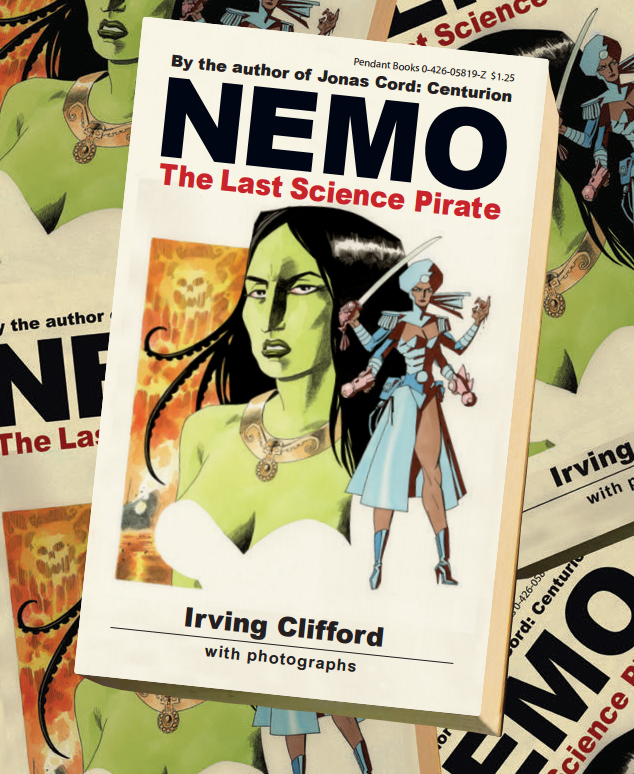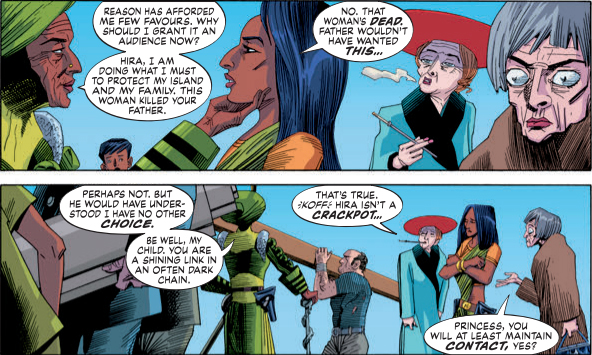“It’s strange being in families like ours, isn’t it?” says Jack, grandson of the fearsome Captain Nemo, moments before he’s stabbed in the back. “These old feuds and grudges from so long ago.” It’s a moment that encapsulates Nemo: River of Ghosts: the next generation may try to move forward, but there’s always someone lurking in the shadows, unable to let the past go.
Nemo: River of Ghosts concludes the trilogy that Alan Moore and Kevin O’Neill began with Nemo: Heart of Ice and Nemo: Roses of Berlin, and completes the bloody saga of Janni Dakkar. Introduced in League of Extraordinary Gentlemen: Century, Janni is both the daughter of the original Captain Nemo and “Pirate Jenny” from The Threepenny Opera. (Readers are probably familiar with the overall League of Extraordinary Gentlemen concept, where characters from all corners of fiction are part of a shared world that is often an alternate history of our own.) In Century, Janni tried to escape her father’s legacy, but after a horrific sexual assault, she embraced her pirate heritage and razed London in revenge. This was a particularly sour moment in the League saga, a blatant use of the “rape as origin story” that’s plagued female characters in comic books for a long time. The Nemo series has been rewarding, then, for its fantastic development of its protagonist Janni into a ruthless, captivating pirate queen who is not defined by her origin.
Nemo’s final adventure begins in 1975. Now in her twilight years and surrounded by spirits only she can see, Janni is disturbed by rumors that her old enemy Queen Ayesha survived their fateful encounter in Berlin and is now in South America. With a small crew—including the Ishmael family, strongman Hugo Coghlan, and her stowaway grandson Jack—Nemo travels past famous fictional hotspots The Lost World and the Black Lagoon, only to find the remnants of two evil empires using horrific means to resurrect their former glory.
As with previous League books, River of Ghosts is an ode to the pop culture of its time period: here, the yellowed paperbacks, men’s sweat magazines, and exploitation films of the sleazy seventies. Kevin O’Neill’s angular artwork adeptly captures the slick feel of 1970s poster design: the faux-Nazi robot women on the cover look like they just walked off the Isla: She-Wolf of the SS one-sheet. It’s always been fascinating to watch Alan Moore stitch together a universe from different parts of pop culture, and in Nemo it feels less strained than the obscure, mystical game of “spot the references” that weighed down Century. River of Ghosts in particular owes a lot to novelist Ira Levin, whose 1970s horror thrillers The Stepford Wives and The Boys from Brazil still linger in the public consciousness—Moore drawing a dotted line from the mechanical Maria of Metropolis to the blonde automatons of The Stepford Wives makes perfect sense in the context of this shared fantasy world.
Other references fall with a clattering thud. The least successful character in the book is Hugo Coghlan, based on an obscure, early twentieth century comic strip character sometimes considered the first “superhuman” comic hero. With his exaggerated physique and boorish manners, Coghlan adds some comic relief to the book (and it looks like O’Neill had a blast drawing him), but as a reader who has no previous attachment to his character or the archetype he represents, I found his scenes flat. I’m also so accustomed to the League books using fictional stand-ins for real historical figures, such as Charlie Chaplain’s The Great Dictator replacing Adolf Hitler, that I was thrown out of the book whenever real names were mentioned. There’s something bizarrely off-putting about actual Nazi war criminal Josef Mengele standing next to Vincent Price’s character from Dr. Goldfoot and The Bikini Machine.
But Nemo: River of Ghosts is thrilling whenever its title character is on the page. The Nemo trilogy covers fifty years of her life, and she emerges as a fascinatingly well-developed character. She’s a pirate, a leader, a villain, a mother, and a grandmother, and yet it still feels like she has hidden depths worth exploring. Re-reading all three books, I was struck by the thought that there are very few true female anti-heroes in comic books, at least those not softened by the love of a “good” man or somehow ultimately redeemed. Janni remains ruthlessly determined throughout the book, even when her own grandson thinks she’s a fanatic, and she’s willing to destroy seemingly-innocent children if it means ending Ayesha’s evil forever. Moore and O’Neill’s League series has employed an uneven and often uncomfortable approach to race and gender, but it feels significant to have an action/adventure comic book with an elderly woman of color as the lead. Considering that River of Ghosts borrows heavily from exploitation films and armpit slicks typically aimed at young white men, having Janni as the protagonist is a subversive, enjoyable reversal of expectations. Even buff strongman Hugo Coghlan is ultimately just a bit player in the battle: the real conflict has always been between two women, Janni and Ayesha. Plus, it’s just plain fun to watch Janni destroy Dr. Goldfoot’s buxom, Aryan robot women—literal sex objects.
Nemo: River of Ghosts ends with Janni finally letting go of the past and entrusting the future to her grandson, Jack. Though she couldn’t escape her father’s legacy, she made it her own and became a towering, sometimes terrifying legend herself. In this final volume, Alan Moore and Kevin O’Neill have crafted a sweaty, colorful adventure that’s a fitting end to the Nemo trilogy and some of their best work of the decade.
Nemo: River of Ghosts is available now from Top Shelf and Knockabout.



